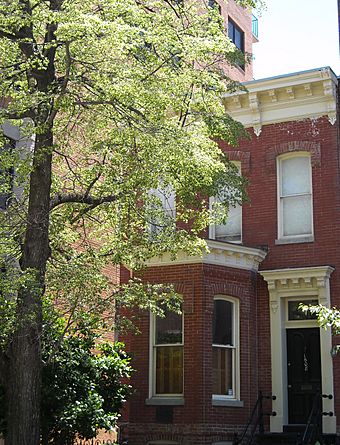Charlotte Forten Grimké House facts for kids
Quick facts for kids |
|
|
Charlotte Forten Grimké House
|
|
 |
|
| Location | 1608 R St., NW., Washington, D.C. |
|---|---|
| Area | less than one acre |
| NRHP reference No. | 76002129 |
| Added to NRHP | May 11, 1976 |
The Charlotte Forten Grimké House is a special historic home in Washington, D.C.. It is located at 1608 R Street NW in the Dupont Circle neighborhood. From 1881 to 1886, this house was where Charlotte Forten Grimké lived. She was an important African-American abolitionist and educator. She was one of the first people from the Northern United States to teach formerly enslaved people and their children in the South during the American Civil War. This house was named a National Historic Landmark in 1976.
About the Charlotte Forten Grimké House
This historic house is found northeast of Dupont Circle. It sits on the south side of R Street. The house is a two-story building made of red brick. It is a type of home called a row house. It has two main sections on the front. On the left side, there is a rounded bay window. The main entrance is on the right. The front door has a special window above it. This window is framed by a decorative hood. The house's exact building date is not known. Charlotte Forten Grimké and her husband, Rev. Francis Grimké, lived here from 1881 to 1885.
Who Was Charlotte Forten Grimké?
Charlotte Forten was born in Philadelphia in 1838. Her family was wealthy and African-American. She grew up surrounded by people who worked to end slavery. This early experience shaped her life. In 1855, she finished her training at a normal school. This type of school trained people to become teachers. After her training, she became a teacher and an activist against slavery.
Her Important Work as an Activist
Charlotte Forten wrote articles for a newspaper called Liberator. This newspaper was very important in the fight against slavery. During the American Civil War, she was chosen for a special project. She went to the Sea Islands of South Carolina. There, she taught formerly enslaved people. This project was known as the "Port Royal Experiment". It helped many people start new lives after slavery.
After the Civil War, Charlotte Forten continued her activism. She strongly supported women's rights, including the right for women to vote. She also kept working as a teacher and writer. In 1894, she helped start the Colored Women's League. This group worked to improve the lives of African-American women. Before the war, she also published poetry. Her poems showed her strong feelings about activism. Her personal journals were reprinted in the 1980s. These journals are very important. They give us a look into the life of a free black woman in the Northern United States before the Civil War.
In 1878, Charlotte Forten married Francis James Grimké. He was the nephew of the famous activist Grimké sisters. The couple lived in this historic house from 1881 to 1885. During this time, Francis Grimké was a pastor. He led the 15th Street Presbyterian Church.


